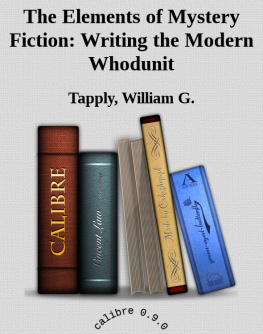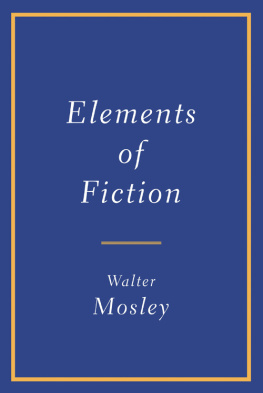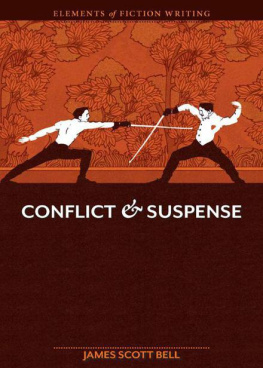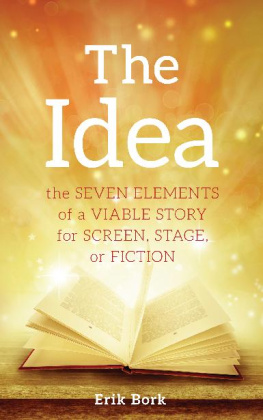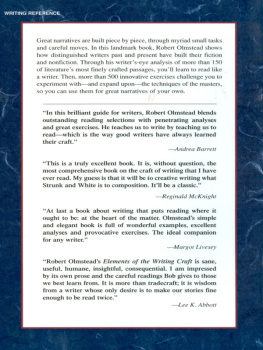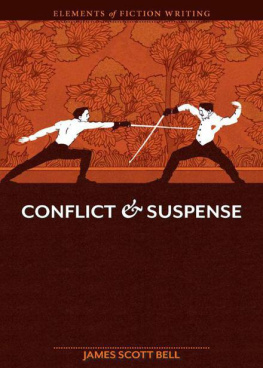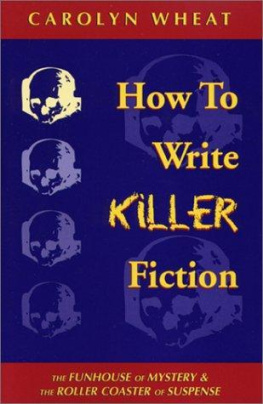Tapply - The Elements of Mystery Fiction: Writing the Modern Whodunit
Here you can read online Tapply - The Elements of Mystery Fiction: Writing the Modern Whodunit full text of the book (entire story) in english for free. Download pdf and epub, get meaning, cover and reviews about this ebook. year: 2004, publisher: Poisoned Pen Press, genre: Detective and thriller. Description of the work, (preface) as well as reviews are available. Best literature library LitArk.com created for fans of good reading and offers a wide selection of genres:
Romance novel
Science fiction
Adventure
Detective
Science
History
Home and family
Prose
Art
Politics
Computer
Non-fiction
Religion
Business
Children
Humor
Choose a favorite category and find really read worthwhile books. Enjoy immersion in the world of imagination, feel the emotions of the characters or learn something new for yourself, make an fascinating discovery.
- Book:The Elements of Mystery Fiction: Writing the Modern Whodunit
- Author:
- Publisher:Poisoned Pen Press
- Genre:
- Year:2004
- Rating:4 / 5
- Favourites:Add to favourites
- Your mark:
- 80
- 1
- 2
- 3
- 4
- 5
The Elements of Mystery Fiction: Writing the Modern Whodunit: summary, description and annotation
We offer to read an annotation, description, summary or preface (depends on what the author of the book "The Elements of Mystery Fiction: Writing the Modern Whodunit" wrote himself). If you haven't found the necessary information about the book — write in the comments, we will try to find it.
Tapply: author's other books
Who wrote The Elements of Mystery Fiction: Writing the Modern Whodunit? Find out the surname, the name of the author of the book and a list of all author's works by series.
The Elements of Mystery Fiction: Writing the Modern Whodunit — read online for free the complete book (whole text) full work
Below is the text of the book, divided by pages. System saving the place of the last page read, allows you to conveniently read the book "The Elements of Mystery Fiction: Writing the Modern Whodunit" online for free, without having to search again every time where you left off. Put a bookmark, and you can go to the page where you finished reading at any time.
Font size:
Interval:
Bookmark:
Books by William G. Tapply
Brady Coyne mystery novels:
Death at Charitys Point
The Dutch Blue Error
Follow the Sharks
The Marine Corpse
Dead Meat
The Vulgar Boatman
A Void in Hearts
Dead Winter
Client Privilege
The Spotted Cats
Tight Lines
The Snake Eater
The Seventh Enemy
Close to the Bone
Cutters Run
Muscle Memory
Scar Tissue
Past Tense
A Fine Line
Shadow of Death
Other novels:
Thicker than Water (with Linda Barlow)
First Light (with Philip R. Craig)
Books on the outdoors:
Those Hours Spent Outdoors
Opening Day and Other Neuroses
Home Water Near and Far
Sportsmans Legacy
A Fly Fishing Life
Bass Bug Fishing
Upland Days
Pocket Water
The Orvis Guide to Fly Fishing for Bass
The
Elements
of
Mystery
Fiction
Writing the Modern Whodunit
William G. Tapply
Poisoned Pen Press
Copyright 1995 by William G. Tapply
Second Edition 2004
10 9 8 7 6 5 4 3 2 1
Library of Congress Catalog Card Number: 2004
ISBN: 978-1-65195-212-0
All rights reserved. No part of this publication may be reproduced, stored in, or introduced into a retrieval system, or transmitted in any form, or by any means (electronic, mechanical, photocopying, recording, or otherwise) without the prior written permission of both the copyright owner and the publisher of this book.
Poisoned Pen Press
6962 E. First Ave., Ste. 103
Scottsdale, AZ 85251
www.poisonedpenpress.com
info@poisonedpenpress.com
Acknowledgments
I am indebted to all of the people who have directly and indirectly encouraged me and taught me how to write mystery novels: My editors Betsy Rapoport, Susanne Kirk, Jackie Farber, Otto Penzler, and Keith Kahla; all those who have read and critiqued my crude first efforts, especially Rick Boyer and Vicki Stiefel; my agents, Fred Morris and the late Jed Mattes; and, of course, my role models, all those writers past and present whose stories have entertained and informed me since I learned to read.
Sylvia Burack first encouraged me to write this book and then edited it relentlessly. Barbara Peters is responsible for the appearance of this new edition, and Rob Rosenwald and Jennifer Semon shepherded it through the production process.
Books would not appear on bookshelves without artists, copy editors, production people, publicists, sales reps, and booksellers. I am grateful to all those Ive worked with over the years for their good work.
Writers could not persevere without the support of family and friends. I am lucky indeed to have had so many unwavering supporters in my corner: My parents, H. G. and Muriel Tapply; my children, Mike, Melissa, and Sarah Tapply; my stepsons, Ben and Blake Ricciardi; Kate Mattes, whos always been there; my colleagues and my writing students at Clark University; and, especially, my wife and my love, Vicki Stiefel, to whom this book is dedicated.
W.G.T
March 2004
Table of Contents
Introduction to the Second Edition ix
Introduction xiii
Part I: Writing a Modern Whodunit
Chapter 1 The Elements of Mystery Fiction 1
Chapter 2 Finding Your Story
Chapter 3 The Protagonist: The Sleuth As
Hero or Heroine 21
Chapter 4 The Lineup: Villains, Victims, Suspects, and
Other Characters 33
Chapter 5 Point of View: Giving Your Reader a
Place to Stand 43
Chapter 6 Setting: The Scene of the Crime 59
Chapter 7 Getting It Started: Setting the Narrative Hook 71
Chapter 8 Structuring the Story: Building Tension 79
Chapter 9 Building Conflict to Make Scenes Work 91
Chapter 10 Dialogue: The Lifeblood of Mystery Fiction 99
Chapter 11 Getting It Right: Rewriting and Revising 111
Part II: Other Important Considerations
Chapter 12 Writing the Mystery Series, 119
by Philip R. Craig
Chapter 13 Standalone or Series Mystery? 127
by Bill Eidson
Chapter 14 Seeing Double: Making Collaboration Work, 139
by Hallie Ephron
Chapter 15 Doing Business with Agents, 147
an interview with Fred Morris
Chapter 16 Editing and Publishing Mysteries, 155
an interview with Barbara Peters
Chapter 17 The Bookselling Business, 167
an interview with Otto Penzler
Chapter 18 Catch 23: Publicizing Your Mystery Novel, 173
an interview with Jeremiah Healy
Chapter 19 Persistence, 181
an interview with Vicki Stiefel
Introduction
to the Second Edition
A decade ago when I wrote the first edition of this book I worked on an Apple IIe computer. It had no hard drive. The manuscript was printed out on tractor-feed paper in dot matrix and submitted via the United States Postal Service. I saved the text on five-inch floppy disks. It took four of those disks to hold it all.
Today, five computers and ten years later, I am submitting this second edition electronically and saving it on both my hard drive and a CD. All of the additional material that the other contributors wrote came to me attached to emails.
A lot has changed in the world of mystery fiction in the last decade besides the writing technology. Now we have online bookstores. Chain super-bookstores have sprung up like mushrooms after a spring rainstorm. We have print-on-demand books and E-books. Tradition-drenched old independent New York publishing houses have become imprints under the umbrellas of giant multinational conglomerates. Small specialty publishers have popped up all over the country to fill the void .
New best-selling authors have burst upon the mystery scene in the past ten years. Several old best-selling authors have passed from the scene.
But some things havent changed. Good books are still good books, and theyre written by solitary, dogged people who know what theyre doing and who are willing to hunch over their writing machines for hours every day, through sickness and health, fair weather and foul, month after month to do it.
The elements of mystery fiction and the ways of the successful mystery writer remain constant. Classroom teachers, workshop leaders, and writing tutors who have used The Elements of Mystery Fiction with their students have told me not to change a word of it.
They have, however, reported that the first edition fails to address a number of issues that their students repeatedly and predictably raise, issues such as: What are the pros and cons of writing a mystery series versus a standalone thriller? What about collaborating on a novel? Why does everybody insist that an author needs an agent? How do the publishing and bookselling businesses really work? If my novel gets published, how can I help promote it? And the universal question that haunts aspiring mystery writers: Recognizing the odds, do I really have a chance of ever seeing my book in print? Why shouldnt I give up this quixotic dream and take up cabinet making, or gardening, or rock climbing?
To address these valid and important issues, I invited, begged and bribed some of the most prominent and successful people in the mystery business to share their experience and expertise for this new edition.
Philip R. Craig (Chapter 12: Writing the Mystery Series) is the creator of the long-running Marthas Vineyard mystery series featuring ex-cop, surf fisherman, gourmet cook, and all-round good guy J. W. Jackson. Phils books have been touted on the television show Good Morning America.
Bill Eidson (Chapter 13: Standalone or Series Mystery?) has published six standalone novels, three of which have been optioned for movies. Bills most recent novel, The Repo , is the first in a new mystery series.
Hallie Ephron (Chapter 14: Seeing Double: Making Collaboration Work) is half of the G. H. Ephron team that has collaborated on four (and counting) popular and critically acclaimed mystery novels featuring psychiatrist Dr. Peter Zak.
Next pageFont size:
Interval:
Bookmark:
Similar books «The Elements of Mystery Fiction: Writing the Modern Whodunit»
Look at similar books to The Elements of Mystery Fiction: Writing the Modern Whodunit. We have selected literature similar in name and meaning in the hope of providing readers with more options to find new, interesting, not yet read works.
Discussion, reviews of the book The Elements of Mystery Fiction: Writing the Modern Whodunit and just readers' own opinions. Leave your comments, write what you think about the work, its meaning or the main characters. Specify what exactly you liked and what you didn't like, and why you think so.

